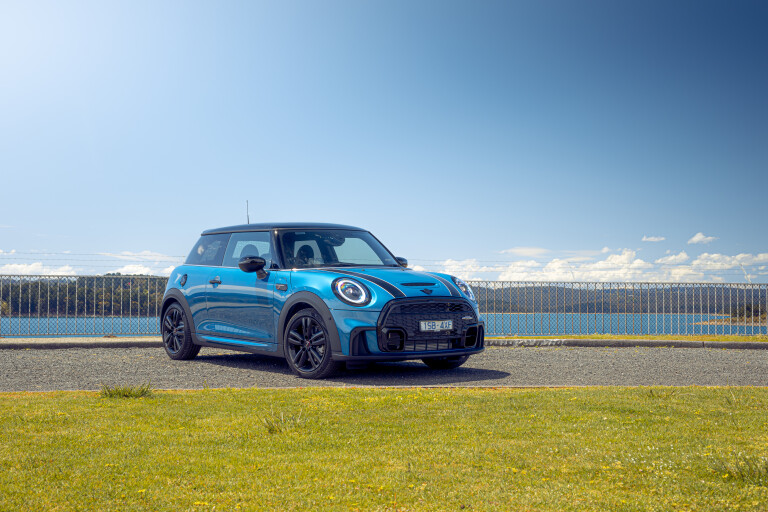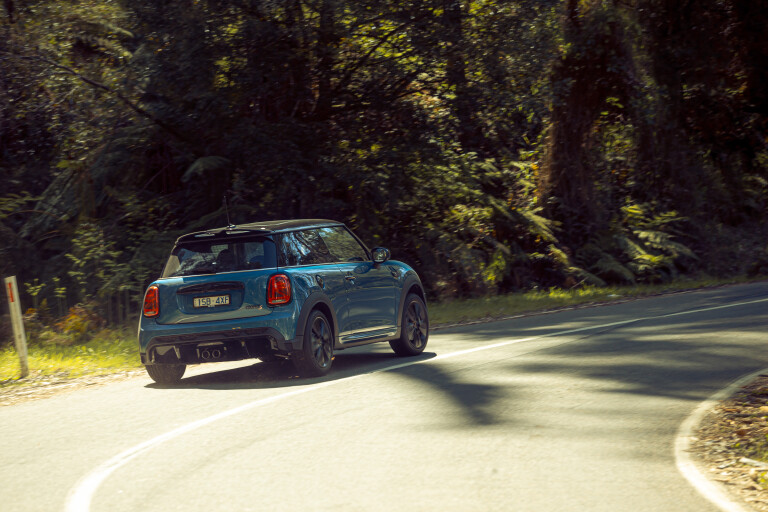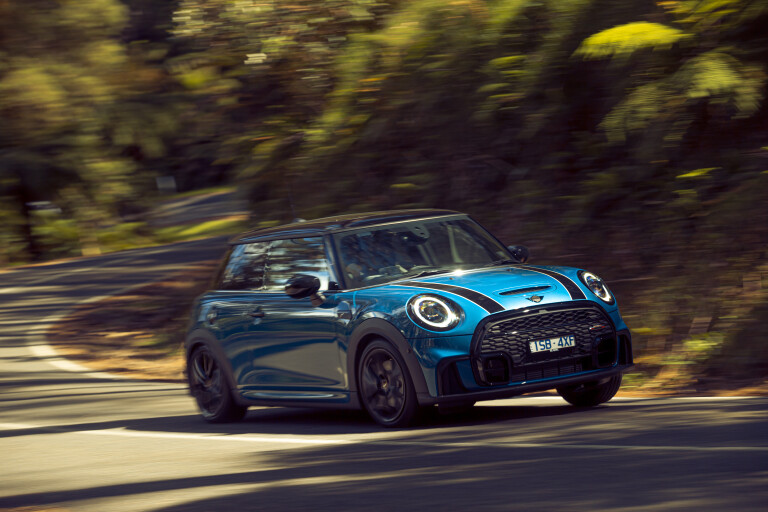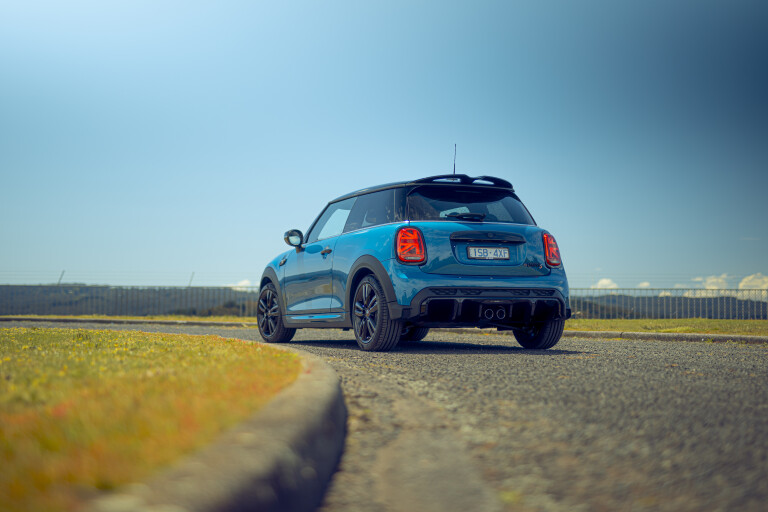
Score breakdown
Things we like
- Nails its style brief
- Upmarket feel
- Improved ride
Not so much
- Getting very expensive
- Dynamics need fun injection
- Missing tech
You have to hand it to BMW; the Bavarian giant really knows its target market when it comes to the Mini. And it plays hardball to get those sales, offering myriad modernised versions of the traditionally British hatch. Compared to the now-departed Volkswagen Beetle, it’s hard to argue that the retro-remake Mini hasn’t been a success.
It’s BMW’s thorough knowledge of its USP that makes the Mini popular. And it doesn’t just subtly lean on nostalgia, it whacks you in the face with it. Even after 20 years and in its third generation, the throwbacks are hard to escape. Its cutesy face has received a nip and tuck to look slightly more aggressive while the Union Jack is proudly displayed within the tail-lights, just in case anyone forgot its heritage.
Proof that there was a Mini niche uncatered for is in the inclusion of this variant, the Cooper S JCW Sport. Essentially, it looks like a full-fat JCW with 170kW and 320Nm, but runs on the skim milk of a Cooper S with 141kW and 280Nm from its BMW-sourced B48 engine. Except for some red accents, it’s hard to tell the two apart. And that’s the point. It gains the JCW aero package, including a chin spoiler, side skirts, oversized rear diffuser with central exhaust and a rear wing. It even runs the same 17-inch alloys and optional stripes.

It’s available as a three-door (like a Cooper should be) and five-door, with the 2.0-litre turbo four-cylinder powering the front wheels through a seven-speed dual-clutch gearbox. However, all this extrovert sportiness comes at a price. And for its $53,200 three-door sticker – before on-road costs – you could buy a sorted hot hatch from another brand, or even the JCW itself. However, Mini has always played in a boutique class of its own where what’s underneath the clamshell bonnet usually plays second fiddle to the statement it projects.
Still, with a 0-100km/h time of 6.7 seconds, the mechanical gubbins aren’t exactly lacking. The 1998cc four-cylinder turbo offers up a meaty 280Nm from as low as 1250rpm and peak power is competitive for the class at 141kW (at 5000rpm). The latter does tend to tail off near the top-end of the rev range, but it is punchy and motivates the 1225kg mass swiftly enough. Three driving modes are available (Sport, Mid and Eco), with the raciest setting delivering a very sensitive throttle calibration. However, it sounds the best in this mode, with a raspy exhaust note and blow-off valve histrionics that’ll make you chortle.

The seven-speed dual-clutch is an amicable companion for the ‘TwinPower’ unit and performs shifts at a faster pace than the torque-converter auto used in the proper JCW. It rev-matches when clicking down the ratios and offers up gears when you want them – most of the time. The steering wheel-mounted paddles fall nicely to hand behind the thick rim of the tiller. What doesn’t work is having the volume ‘up’ control so close to the three o’clock hand position. It’s all too easy to turn the volume up to 11 unintentionally.
Upping the tempo on-road doesn’t yield the type of responses you’d hope for, though. Buying into the Cooper S persona used to mean go-kart handing cloaked in a catwalk-ready body. And despite the Sport mode proudly displaying an image of said go-kart, the experience doesn’t live up to the decal. Let’s be clear; the Mini isn’t a bad handling hatch, it just doesn’t feel as fun as you think it’s going to be – or want it to be.
Mini has always played in a boutique class of its own where what’s underneath the bonnet plays second fiddle to the statement it projects.

Body roll is kept to a minimum and composure is strong through changes of direction but although the steering is quick, it returns inconsistent weighting. If you don’t get the Cooper S JCW Sport moving it will fall into understeer, a fact that isn’t helped by the Pirelli Cinturato rubber. You can engage the multi-link rear axle for a bit of extra rotation, but it requires big inputs from the steering or an aggressive lift of the accelerator. It feels stuck in its shoes without the verve found in the previous R56 generation Mini.
Where it has improved is in terms of ride quality. And surprisingly, this is after BMW removed the electronically controlled dampers, replacing them with a passive set-up. They now use a special valve (a bit like a Ford Fiesta ST) that opens over big compressions. Like its Blue Oval competitor, the idea is that the firmness generates sporty handling with rebound being smartly suppressed most of the time, while the valving quells bigger hits. Admittedly, it isn’t the final word in plushness but it is noticeably more comfortable than the JCW, making it the one to drive daily.

Modern Mini buyers appreciate this fact. And on top of the JCW costume, the interior gains special treatment, too. There is something to be said for feel-good factor – and the Mini has just enough funk and quality to have that measure in its favour. The Cooper S JCW Sport gains goodies like an Anthracite headliner, ambient lighting (changeable via a roof-mounted toggle), Dinamica/leather JCW Sport seats, panoramic sunroof, Harmon Kardon sound system and head-up display. There are also John Cooper Works badges throughout to remind you it isn’t a base Cooper S.
Like the exterior, the interior is unique. Quirky in the extreme. Yet, two decades on and with the aid of kit like BMW iDrive, it all seems to work. Form isn’t blatantly usurping function. High-quality materials abound and the chequered silver inlays are a nice touch. The circular dash design is now offset by a digital instrument cluster, although the rev-counter needle remains analogue if you look closely. The aeroplane-style switches are ergonomic wins and there’s enough adjustment in the driving position for most.
Like the exterior, the interior is unique. Quirky in the extreme. Yet, two decades on, it all seems to work.

Infotainment is now taken care of via an 8.8-inch touchscreen display, its rectangular shape juxtaposing the circular housing and barcode-style mood lighting. In terms of mirroring, wireless Apple CarPlay is standard, but those using Android will be left disappointed. As will those who prefer big phones, as they won’t fit in the wireless charging pad located oddly in the centre armrest. Either could be equally as frustrating depending on what smartphone you have.
Practicality has never been the reason you buy a Mini, especially a three-door with its 72mm shorter wheelbase than the five-door. Realistically you aren’t going to be ferrying rear-seat passengers often. And if you do, they’d better be small and nimble as entry and egress is hampered by a relatively tight opening, while legroom in the back is limited. The fact that there aren’t any charging ports or air vents back there is a sure sign this will be extra cargo capacity. Reflecting the diminutive dimensions is a 211-litre boot, which does expand to 731 litres with the rear seats folded.

This new Cooper S addition has all the show, but none of the extra go. Which means the equation doesn’t quite add up in a performance sense and the $50K spend will get you behind the wheel of tastier options. However, for those buying into the dream and the associated storyline, that won’t matter. The Mini Cooper S JCW Sport was made for them by decisions from within BMW’s marketing team. It’s their perfect slice of kitsch.
2021 Mini Cooper S JCW Sport specifications
| Body | 3-door, 4-seat hatch |
|---|---|
| Drive | front-wheel drive |
| Engine | 1998cc inline-4, DOHC, 16v, turbo |
| Bore/stroke | 82.0 x 94.6mm |
| Compression | 11.0:1 |
| Power | 141kW @ 5000rpm |
| Torque | 280Nm @ 1250-4750rpm |
| Transmission | 7-speed dual-clutch |
| Weight | 1225kg |
| Power/Weight | 115kW/tonne |
| Front suspension | A-arms, coils springs, dampers, anti-roll bar |
| Rear suspension | multi-links, coil springs, dampers, anti-roll bar |
| L/W/h | 3876/1727/1414mm |
| Wheelbase | 2495mm |
| Tracks (f/r) | 1485/1485mm |
| Steering | electrically assisted rack-and-pinion |
| Front Brakes | 295mm ventilated discs, single-piston calipers |
| Rear Brakes | 260mm solid discs, single-piston floating calipers |
| Tyres | 205/45 R17 (f/r) Pirelli Cinturato P7 |
| Wheels | 17.0 x 7.0-inch (f/r) |
| Price | $53,200 + ORC |
Score breakdown
Things we like
- Nails its style brief
- Upmarket feel
- Improved ride
Not so much
- Getting very expensive
- Dynamics need fun injection
- Missing tech

COMMENTS